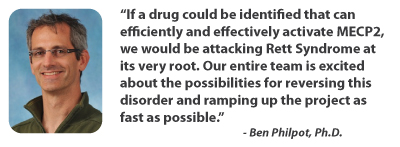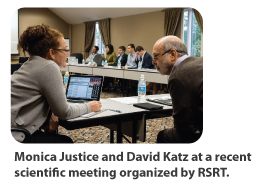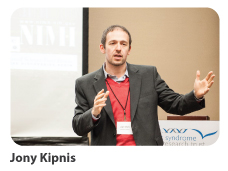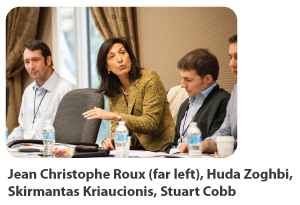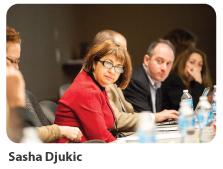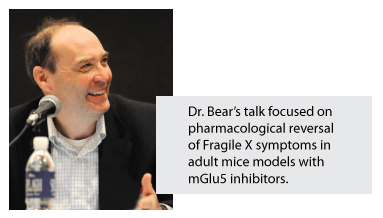You are currently browsing the tag archive for the ‘Ben Philpot’ tag.
by Monica Coenraads
There is no mystery about why a girl suffers from Rett Syndrome. The cause is the mutated copy of the MECP2 gene inhabiting her cells. But since MECP2 is on the X chromosome and all females have two X’s, beside each mutated gene rests a healthy but silenced twin. What if we could replace the flawed gene by reawakening its silenced counterpart? If we could wake up MECP2 in enough cells we could conceivably reverse Rett symptoms.

This is an approach that RSRT has championed since our launch in 2008. We are funding seven labs that are pursuing this line of work.
You may ask why do we need multiple labs working on the same goal. Isn’t that a waste of effort and money? The answer is a resounding “NO”. While the end game is the same each lab is using a different strategy to get there.
For example, the types of cells that labs are utilizing are different. Ben Philpot and colleagues at UNC are working with mouse neurons, Toni Bedalov and Jeannie Lee are using fibroblast cells, others still are using human cells. Each cell type has its own set of advantages and disadvantages.
The labs are also using different “reporters” – meaning how the cells are designed to detect activation of MECP2. Different compound libraries at different concentrations are being screened. Compounds are also being screened at various degrees of high and low throughput. And finally different criteria are being employed to define a “hit” (drugs that reactivate MECP2).

Bryan Roth gives us a tour of his robotic high-throughput
screening facility at UNC Chapel Hill
Having multiple labs attack this problem gives us more shots on goal and added assurances regarding the quality of any potential hits.
Two weeks ago we gathered everyone tackling this approach and brought them together for two intense days of talks and discussions.
Targeting MECP2 as a Treatment Strategy for Rett Syndrome
Chapel Hill, NC
May 12-13, 2014
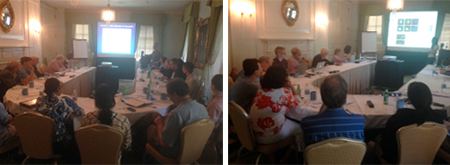
Seventeen scientists from eight labs
plus advisors from NIH and industry participate at meeting in Chapel Hill, NC.
Over the past 15 years I’ve organized dozens of meetings and before each one I worry – will the discussions be forced or will they flow naturally? will collaborations ensue? It was no different with this meeting. The first few talks of the day however quickly put me at ease. While a number of common hits were reported in multiple labs much validating and further screening remains to be done. At the meeting, and in emails and phone calls since, the scientists are working out the logistics of validating each others hits, trading cell lines and compounds. Exactly the outcome I was hoping for.
by Monica Coenraads
RETT SYNDROME RESEARCH TRUST WEBSITE
 For almost 15 years now, I’ve been immersed in the science behind Rett Syndrome. As Executive Director of RSRT I understand that the work is methodical, that good research takes time, that breakthroughs often come after many tiny, incremental steps. And yet, as a mother witnessing my 16-year-old daughter deteriorate a little more each year, I feel a great urgency to push the research harder and faster. All families with intimate, daily experiences of Rett Syndrome’s harsh rule know the longing for their children to be free and well. RSRT is one-hundred-per-cent focused on that ultimate goal – and that’s what guides our choices about where to invest not just our hard-won funds but our hopes and dreams.
For almost 15 years now, I’ve been immersed in the science behind Rett Syndrome. As Executive Director of RSRT I understand that the work is methodical, that good research takes time, that breakthroughs often come after many tiny, incremental steps. And yet, as a mother witnessing my 16-year-old daughter deteriorate a little more each year, I feel a great urgency to push the research harder and faster. All families with intimate, daily experiences of Rett Syndrome’s harsh rule know the longing for their children to be free and well. RSRT is one-hundred-per-cent focused on that ultimate goal – and that’s what guides our choices about where to invest not just our hard-won funds but our hopes and dreams.
2012 gave us reason to be hopeful. We are grateful for the active engagement of our trustees, the unwavering commitment of the families who fundraise for us and the generous contribution of a wide range of people who give their time and talents freely to help us achieve our goal. We wouldn’t be where we are without the unique global partnerships that we enjoy with Rett Syndrome Research Trust UK and the Rett Syndrome Research & Treatment Foundation (Israel), and with national organizations such as GP2C, Kate Foundation, RMRA. Together you have produced an investment in science that will create a better future for our children.
But that future won’t just happen. Before Rett entered my life, I had never given much thought to the drug development process. Like most people, I assumed that academic scientists, industry and government worked together seamlessly to discover effective therapies for the horrible ailments that afflict us. Nothing could be further from the truth.
There is no “Department of Cures.” Laboratory breakthroughs don’t naturally bubble up and become drugs. The reality is that progress must be relentlessly driven, managed, nurtured and prodded, not to mention funded. It’s a messy, difficult and expensive process that can be slowed and derailed by a multitude of hurdles.
Disease-specific organizations such as RSRT cannot afford to be spectators, passively reviewing proposals and granting money. It is incumbent on us to set the research agenda and to facilitate its execution while staying nimble and vigilant to new opportunities.
Two such opportunities would not currently exist without RSRT: reactivating the silent MECP2 on the inactive X chromosome, and gene modifiers. Following the 2007 reversal, RSRT carefully evaluated the state of Rett research and made the decision to champion these explorations before others had even realized they were, in fact, promising approaches.
Will they lead to a cure? Ongoing research and clinical trials will tell. But in the meantime, RSRT will continue to encourage and support the research that holds the greatest promise to truly change our daughter’s lives. For we have the most to win if we succeed, and the most to lose if we fail.
There is no mystery about why a girl suffers from Rett Syndrome. The cause is that mutated copy of the MECP2 gene inhabiting her every cell. But since MECP2 is on the X chromosome and all females have two X’s, beside each mutated gene rests a healthy but silenced twin. What if we could replace the flawed gene with its perfect counterpart?
That’s the question Ben Philpot of the University of North Carolina at Chapel Hill has asked. RSRT has awarded Philpot, Bryan Roth and Terry Magnuson $2.2 million to answer it.
Philpot’s recent paper in Nature describes successful reactivation of the silenced gene in Angelman Syndrome, demonstrating that replacement is possible.
Joining Philpot and Roth in this effort is Terry Magnusson, a world-renowned leader in X-inactivation. The award will fund a team of three full-time post-docs and two technicians.
The goals of the 3-year project include:
- Screening of 24,000 compounds
- Performing whole genome analyses to test for drug specificity to help predict potential side effects (e.g. what other genes might be affected by the drug)
- Identifying the mechanism of MECP2 unsilencing, which will allow the prediction and design of additional therapeutic targets
- Optimizing drug efficacy through medicinal chemistry (e.g. by designing drugs to maximize transit through the blood-brain-barrier while minimizing off-target effects)
- Advancing lead candidates into preclinical trials. The project will be milestone-driven, with a set of pre-established deliverables. This will allow us to monitor progress utilizing a team of advisors with relevant expertise.
Interview with Benjamin Philpot Ph.D. from RSRT on Vimeo.
Along with activating the silent MECP2, RSRT has championed a second exciting approach.
In her Baylor College of Medicine laboratory, Monica Justice set out to identify modifier genes – altered genes able to dampen the ill effects of an MECP2 mutation.
The common belief has been that these genes would be hard to find. The reality? With the screen just 15% complete, Justice has already found five. What she is seeing in mice implies that Rett-like symptoms are unstable, and consequently easier to revert to a normal state than anyone had suspected.
None of the modifier genes can suppress the disease entirely, but each reduces a subset of Rett-like symptoms. While we had originally thought that the modifiers were specific to the central nervous system, it turns out they may operate elsewhere in the body. At least one of the modifiers suggests an alternative therapeutic target, using drugs already FDA-approved. With RSRT funding Justice is now testing the drugs in mice and has a manuscript currently under review. A clinical trial is being explored.
At RSRT we’re excited about will happen once the screen is completed. Justice is likely to find many more modifiers, some of which may point to tractable pathways. In support of this goal, RSRT has committed an additional $800K to the Justice lab, bringing its total commitment to the modifier screen to $1.5 million. This funding should provide sufficient resources to allow Dr. Justice to reach the 50 percent mark in the screen within two years – at which point she will propose a plan to us for completing the project. Many more modifiers await discovery. Further surprises are likely in store.
We have also awarded funding of $720K to the lab of Jonathan Kipnis at the University of Virginia. Kipnis and colleagues hope to gain better understanding of the immune system’s involvement in Rett by analyzing patient blood. The hope is that immune-based therapies can be developed.
Previous work from the Kipnis lab suggested that bone marrow transplants could be beneficial. Before proceeding to clinical trials with a procedure that is extremely serious and risky, RSRT committed funding in 2012 for independent corroboration of these findings.
We are also supporting Huda Zoghbi’s work to explore whether symptoms of the MECP2 Duplication Syndrome can be reversed once the protein level is normalized. $236K was awarded to this project via the MECP2 Duplication Syndrome Fund through the fundraising efforts of the duplication/triplication families.
RSRT is supporting work at John Bissonnette’s lab at OHSU (Oregon Health & Science University) to explore serotonin 1a agonists for their ability to reduce apneas, and Andrew Pieper’s lab at UTSW (University of Texas – Southwestern) for ongoing drug screening.
Finally an award of $65K was made to Dr. Sasha Djukic for her work at the Tri-State Rett Syndrome Center in the Bronx, NY with the majority of the funds coming from the annual Reverse Rett NYC event.
Please join me in wishing all of our scientists Godspeed. I look forward to keeping you apprised of their progress. One last heartfelt thank you to everyone who raises research funds for RSRT. These projects are your money and your effort at work.
Photo credit: Kevin Coloton
RETT SYNDROME RESEARCH TRUST WEBSITE
Last month brought me to Houston, Texas to attend a fascinating meeting organized by Huda Zoghbi and Morgan Sheng and co-sponsored by RSRT. Entitled Disorders of Synaptic Dysfunction, the event was the inaugural symposium of the recently established Jan and Dan Duncan Neurological Research Institute, directed by Dr. Zoghbi.
The two-day meeting brought together a heterogeneous group of scientists from academia (senior and junior faculty as well as post-docs and graduate students), industry, NIH and other funding agencies.
The focus was not on a single disease but rather on a group of disorders (Rett, Angelman, Fragile X, autism, Tuberous Sclerosis) that share a common cellular phenotype: abnormal synapse activity.
It’s no surprise that some of the talks that generated the most buzz came from labs that are doing very clinically relevant research. These include the labs of Mark Bear at MIT, working on Fragile X, and Ben Philpot at UNC whose lab works on Angelman Syndrome.
Like Rett Syndrome, Fragile X is a single gene disorder, caused by mutations in a gene called Fmr1. When Fmr1 is mutated, protein synthesis fails to shut down, leading to excess. Some years ago Dr. Bear proposed that compounds which can block a certain type of receptor, mGluR5 (which triggers the burst of synaptic protein synthesis) might counteract over-expression of protein and thereby cancel out the damaging effect of Fmr1 deficiency. His theory has proved correct, and clinical trials of mGluR5 antagonists are currently ongoing at multiple pharmaceutical companies.
I first met Dr. Bear almost a decade ago, when he was just beginning to formulate what is now commonly known as the mGluR5 theory of Fragile X. His lab is currently funded by RSRT to explore protein synthesis in the Rett mouse models. Dr. Bear hypothesizes that Rett may be due to under-expression of proteins. If his hypothesis holds up, pharmacological manipulations of mGluR signaling will be pursued.
Ben Philpot’s talk also generated excitement. He discussed a high-throughput screen that has yielded a compound which can activate the silenced Angelman Syndrome gene, UBE3A. Dr. Philpot is currently funded by RSRT to pursue a similar approach for the silent MECP2 gene on the inactive X chromosome.
Mike Greenberg spoke about MECP2 and shared unpublished data that has come about from his collaboration with Adrian Bird via the RSRT funded MECP2 Consortium. (More on that in the months to come.)
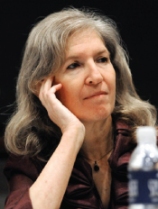 Jackie Crawley of the NIH gave a brilliant talk on how “autistic mice” are being characterized to yield a plethora of new information. For me the highlight of her talk was hearing recordings of mouse “speech”. She shared a variety recordings and I was taken aback by the complexity and richness of the sounds, which left me yearning for an analysis of Rett mouse vocalizations.
Jackie Crawley of the NIH gave a brilliant talk on how “autistic mice” are being characterized to yield a plethora of new information. For me the highlight of her talk was hearing recordings of mouse “speech”. She shared a variety recordings and I was taken aback by the complexity and richness of the sounds, which left me yearning for an analysis of Rett mouse vocalizations.
After a lively cocktail hour it was back to work with dinner plates in hand. Drs. Zoghbi and Sheng divided the attendees into three working groups: 1) dysfunction of proteins of the synapse 2) dysfunction of nuclear/cytoplasmic proteins 3) young investigators and junior faculty. Masquerading as a 30-something I happily joined the third group. I was struck by the fearlessness and boldness of these young scientists. There were not shy about criticizing the status quo and what could be done differently to enhance the research progress. I came away feeling buoyed and reassured that science is in good hands with this new generation.
The following several hours of discussion, led by Rodney Samaco and Mingshan Xue and facilitated by NIMH Director, Tom Insel, were intellectually stimulating and entertaining. Below is a visual output of our intense discussion.
A few personal reflections on the symposium
- Over and over again throughout the meeting I heard comments from autism researchers such as: “Where would we be without the syndromic autism animal models like Rett and Fragile X? We’ve learned so much from them”. More than once I found myself thinking that as horrible as Rett is at least the genetics of the disorder are clear-cut – Rett’s silver lining.
- The meeting provided an opportunity to meet some scientists with whom I had communicated by email and/or phone, but never met in person. People like Pat Levitt, Freda Miller and Michael Palfreyman. It was a reminder of how many people over the years have taken the time to discuss their work and possible synergies to Rett Syndrome.
- Drs. Zoghbi and Sheng kept everyone busy from the moment the meeting started to the moment we left, including an intense working dinner. I tend to do the same thing at meetings that I organize, but always feel like I’m being a bit of a slave driver. Never again, however, will I feel guilty. If Dr. Zoghbi thinks it’s acceptable, then so do I!
Kudos to Drs. Zoghbi and Sheng for a stimulating meeting and thank you both for inviting me.
Science Translational Medicine, which co-organized the meeting, will be publishing a white paper on the proceedings.
RSRT will let you know when the paper is available.
RETT SYNDROME RESEARCH TRUST WEBSITE
Those of you who follow the efforts of RSRT know that one of the treatment strategies we are pursuing is the reactivation of the MECP2 gene on the inactive X chromosome.
A quick refresher for those in need of one: mutations in MECP2 cause Rett Syndrome (and a host of other disorders as well). MECP2 is on the X chromosome. Males have one X (and one Y) and females have two X’s, but in order to prevent duplication of genetic material randomly inactivate one of the X’s in every cell. This means that in females with Rett about 50% of cells have the normal MECP2 gene expressed and 50% have the mutated gene expressed. In theory, if we can find a way to reactivate the normal MECP2 gene on the inactive X chromosome, we may cure the disease.
RSRT funded investigators currently pursuing this line of inquiry include Antonio Bedalov of the Fred Hutchinson Cancer Research Center in Seattle, Marisa Bartolomei of UPenn and Ben Philpot and Bryan Roth of UNC.
The reactivation effort now has a new player – Jeannie Lee, M.D., Ph.D. of Harvard University. She is a leader in the X chromosome field and we welcome the significant intellectual and technological resources that she will bring to this endeavor.
MC: Congratulations Dr. Lee on receiving RSRT funding. Tell us a bit about yourself and how you came to be interested in Rett Syndrome.
JL: Growing up I dreamed of being a physician. While I was in college I got involved in undergraduate research and I realized that I really enjoyed doing research. During my senior year I couldn’t decide whether to become a physician or pursue my new-found interest – science, so I decided to keep my options open and enrolled in an MD/PhD program at Penn. By my third year I realized I wasn’t going to practice medicine and would instead hope to make contributions to medicine via science. My interest in X chromosome inactivation (XCI) began as a graduate student in the lab of Robert Nussbaum.
MC: Dr. Nussbaum was actually one of the first scientists that I connected with in 1998 when my daughter was newly diagnosed. He was very kind and offered lots of practical and helpful advice as I started the Rett Syndrome Research Foundation (which later merged with IRSA to become IRSF).
JL: He was a great mentor. In his lab I worked on Fragile X. While attending various genetics meetings I heard some interesting talks on XCI that really caught my attention. I chose to do my post-doc in Rudolf Jaenisch’s lab at MIT and that is when I began working on XCI. Although the Jaenisch lab was not an XCI lab, all the necessary tools were there. Jaenisch was very well versed in knockout technology and transgenics and the lab was full of very bright people. So for me, it was the perfect place to be.
I set up my own lab at Harvard in 1997 and have been working on XCI ever since. To better understand the mechanics of XCI, I incorporated more molecular biochemistry-driven approaches to the mouse system. During the past few years I’ve been thinking more and more about how to apply the lab’s experience, tools and resources to a clinical problem and Rett is the perfect choice.
MC: Why Rett and why now?
JL: Combination of two things. One, the realization that Rett is curable. There is the beautiful mouse model work of Adrian Bird that shows us that you can be born with this deficiency and be cured through gene therapy or reactivation of the normal copy of MECP2. That is profound. How many congenital diseases can we say that about? Rett is one of those congenital genetic diseases for which a cure could actually happen.
And two, the tools are in place to do the necessary experiments. I feel the time is right to take the platform technologies we’ve developed and use them to identify potential therapeutics for diseases. Rett is definitely one of the targets. I’ve been interested all along in applying knowledge of basic principles to cure disease but needed to develop the tools first. We’d rather start simple and Rett gives us this chance.
MC: I don’t think I’ve ever heard Rett referred to as “simple” but I’m sure glad you think so.
JL: Simple from a mechanistic standpoint because Adrian has already shown us that it can be reversed, and that, together with the fact that Rett is a single gene disorder, which is a huge advantage, gives us hope that we’ll succeed, that we won’t be working in vain. There is actually a huge amount of interest in Rett from the scientific community.
MC: Let’s talk about the experiments you are proposing. Your plan is to develop an assay using mouse cells that will glow when the inactive MECP2 gene is activated. You’ll be using the screening facilities of the Broad Institute in Cambridge, MA, which are quite impressive.
The Broad is really a unique facility – an experiment of sorts about a new way to tackle science. It brings together an eclectic group of scientists from its partner institutions that include MIT, Harvard and the affiliated major teaching hospitals (Beth Israel Deaconess Medical Center, Brigham and Women’s Hospital, Children’s Hospital, Dana-Farber Cancer Institute, and Massachusetts General Hospital). The combination of some of the best minds, unprecedented technological resources and some pretty deep pockets makes for a fertile working environment.
JL: Yes, that’s right. We are quite excited about the project and our ability to leverage the resources of the Broad. We will work with Stuart Schreiber and Nicky Tolliday and others who run the high-throughput screening group within the Broad Institute Chemical Biology platform. They have the know-how and the necessary robotic devices. We simply would not be able to conduct this screen without the Broad.
MC: Just this week an interesting paper was published in Nature describing a class of cancer drugs called topoisomerase inhibitors that have the ability to activate the silent UBE3A gene in Angelman Syndrome. The work was spearheaded by Ben Philpot and Bryan Roth who now have RSRT funding to pursue a similar approach for MECP2. This work provides strong proof-of-concept that these screens can work.
JL: The paper is exciting and promising. I do believe our screen is going to work.
MC: Dr. Lee, we wish you the best of luck as you begin this project and look forward to hearing about your progress. Happy holidays to you, your family and your lab.
Below is a short video of Nicky Tolliday explaining the Broad’s high-throughput screening capacity.




